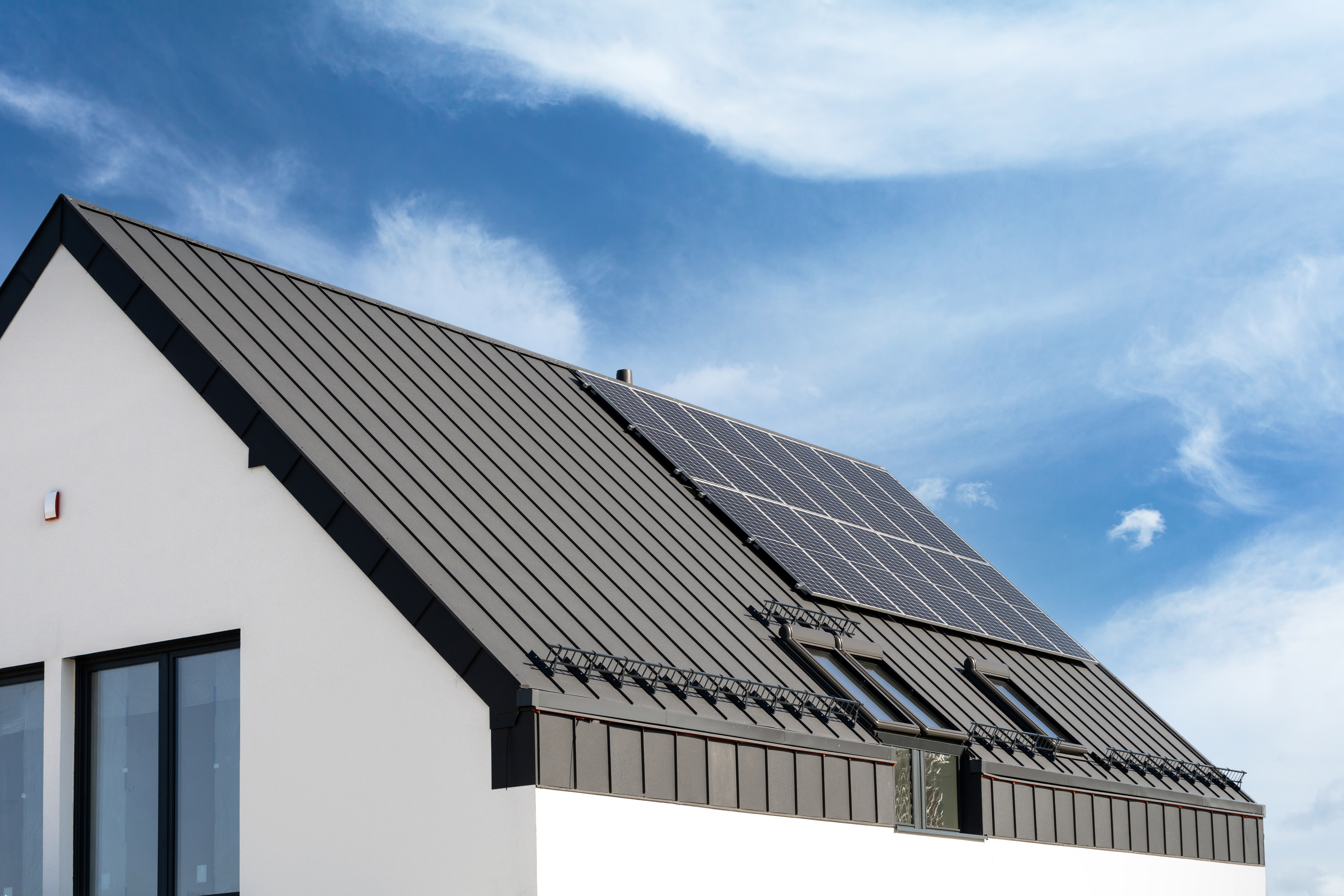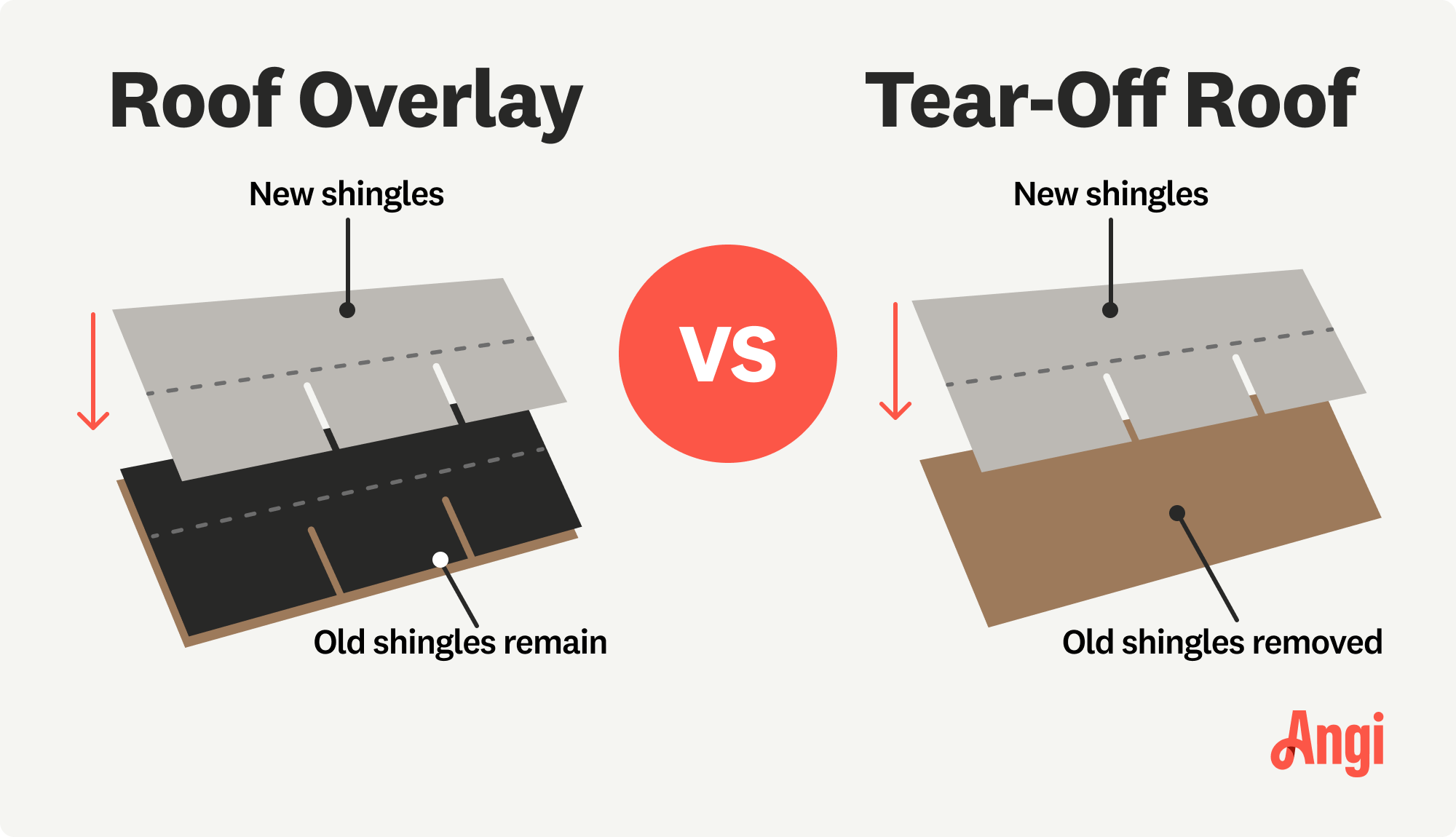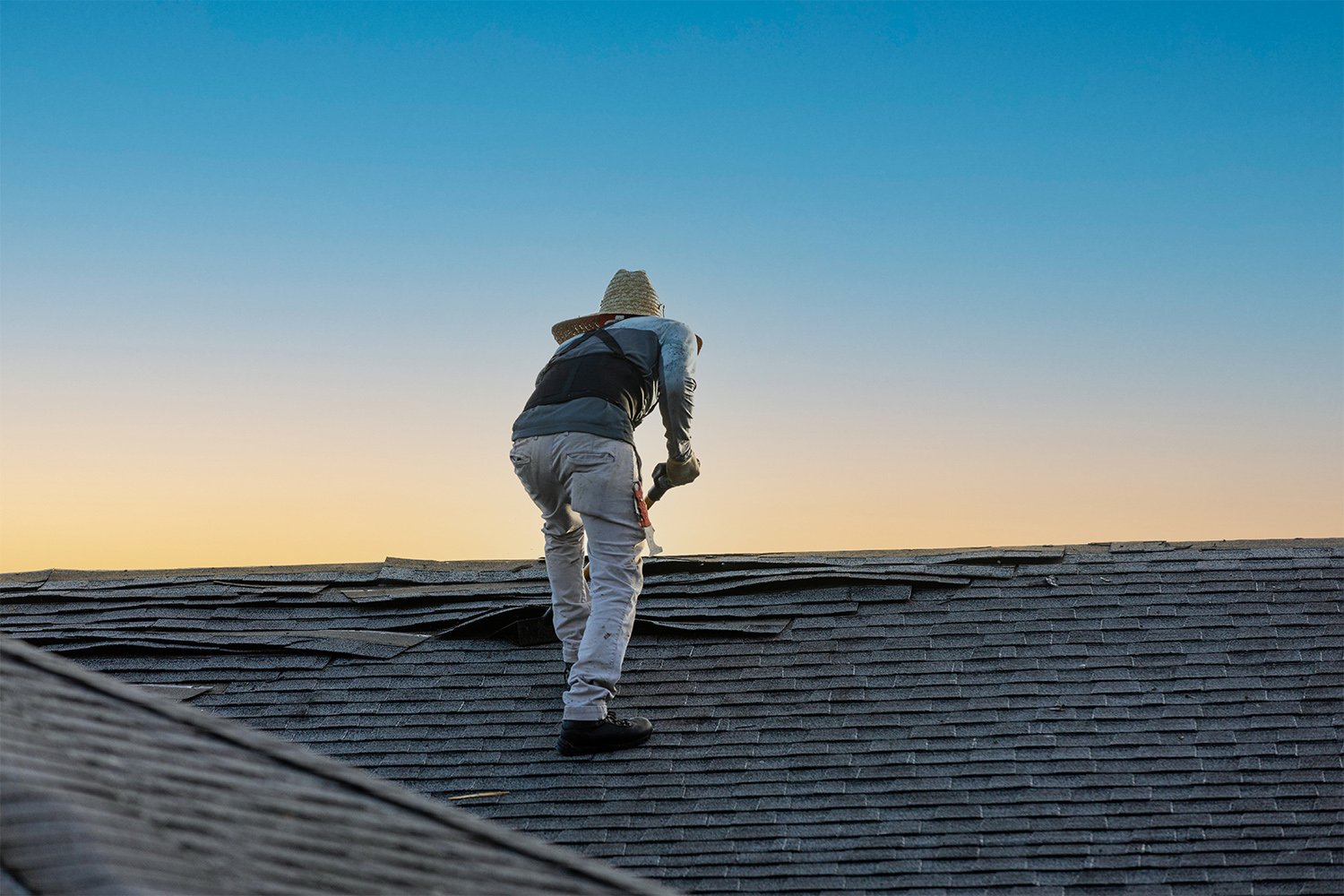
A metal roof can defend your home against Ohio’s varying weather conditions. Learn how much a metal roof costs in Columbus, OH.
Don’t tear out your hair trying to figure out if you need to tear off your roof


Roof overlays and tear-off roof replacement are the two most popular roof replacement options.
An overlay adds new shingles on top of old ones.
Tear-offs involve the total removal of your existing roof.
An overlay is less expensive but masks problems and adds weight to your roof.
A tear-off roof costs more but lasts longer and addresses roof issues.
Replacing your roof is a major investment, so you’ll want to make the best choice to ensure your home stays safe and protected. When it comes to roof replacement, two options stand out—roof overlay and tear-off. This guide will explore these two methods, their pros and cons, and how they measure up against each other so you can make the best choice for your home and your budget.

A roof tear-off involves completely removing your existing roof. Every part of your roof will be replaced with new materials, allowing you to address any issues with your old roof by starting fresh. It is also an opportunity to use stronger materials and methods, such as torch-down roofing. While your old roof may not have any specific problems, investing in a tear-off and upgrade ensures that the new roof will withstand the test of time and weather changes. Opting for a full tear-off and replacement can also enhance your home's resale value.
On the other hand, a roof overlay is the process of adding new shingles on top of the existing ones. A roof overlay can only be done if it's the first time an overlay has been installed. This option is available if you're short on time or money but still want to update the appearance of your roof. While an overlay is less expensive than a tear-off, it won't provide the same level of strength and durability as a completely new roof, and it won't increase the resale value of your home. In addition, it might later mask problems with your roof, such as a leak. It also adds weight to your roof, which can negatively impact the integrity of your roofing structure.
A roof overlay, sometimes called a roof layover, involves installing a new layer of shingles on top of your roof’s existing shingles. It requires your roof’s structural support to be in good condition and can only be done on a roof that hasn’t already had an overlay.
A roof overlay won’t fix problems with the existing roof’s sheathing, underlayment, or other components found under the shingles, so it’s important to confirm that those materials are in good shape before considering an overlay. Let’s explore the pros and cons of roofing over existing shingles.
| Pros | Cons |
|---|---|
| Budget-friendly | Less durable |
| Faster installation | Adds structural stress |
| Same shingle warranty as a new roof | Reduces resale value |
Best For:
Homeowners with a tight budget
Roof replacement with strict time constraints
Homes with roofs in good condition that have not been overlaid before
Roof overlay is one of the most popular methods of roof replacement. Many people use it because it’s affordable and relatively quick to install.
Cost: New roofing costs can be high. Overlay is the most affordable option for roof replacement. With this method, a roofer will cover your existing, damaged shingles with a new layer. This means the cost of labor and materials will be lower than with other methods.
Time: Less labor means less time spent on the project itself. If winter’s approaching and you’re worried about getting the job done before snow arrives, roof overlay is the method to pick.
Warranty: Shingle manufacturers will warranty the shingles, whether they’re used for a full roof replacement or an overlay. An overlay is a great way to get guaranteed shingle performance without the high price tag of a tear-off.
You may eventually forfeit the time and money you save when replacing your roofing sooner than you would with other methods.
Durability: Unfortunately, while less expensive and quicker to get in place, that new top layer of shingles isn’t as durable as other roof replacement methods. That’s because the new shingles trap heat, which strains your shingles.
Structural Stress: When you add an entire new layer of shingles over your old shingling, you’re essentially putting another roof on top of the current one. If you have an older or damaged home, the added weight can cause structural strain and stress over time.
Appearance: Unfortunately, overlay isn’t the most visually appealing choice in every case. Your finished roof overlay will only look as good as your previous roof—dips and curls in the shingles will inform how the new shingles look.
Deck Assessment: When roofers tear off your entire roof, they get an opportunity to examine the deck on which all those shingles sit. During this process, they can assess your deck for potential issues like leaks or rot. With an overlay, that process doesn’t happen and can cause trouble down the line.
Leak Repairs: If you have more than one layer of roofing, it’s very difficult to track and identify a leak’s origin. Any trapped water can move, too, appearing in other places, making patches a problematic and ongoing issue.
Resale Value: Using roof overlay can negatively affect the resale value of your home. Prospective homeowners aren’t looking to replace the roof of the place they just bought, and eventually, with roof overlay, that’s exactly what they’ll have to do.

Tear-off roof replacement involves removing all existing roofing materials, replacing any damaged sheathing or underlayment, and installing all new materials. Tear-off replacement allows you to upgrade materials, find and address any problems with the roofing structure, and get a fresh start with a brand-new roof.
| Pros | Cons |
|---|---|
| More durable | More expensive |
| Less maintenance | Longer installation |
| Adds to resale value | Disposal of old materials |
Best For:
Roofs with damaged sheathing or underlayment
Homes that will be up for sale during the life of the roof
Homeowners who want to do minimal maintenance
Tear-off roof replacement lasts longer, gives you a better sense of its structural integrity, and is of higher quality.
Durability: Plain and simple, the tear-off method lasts longer—because you’re literally tearing off your old roof and replacing it with a brand new one. This means that new shingles will trap less heat, leading to a longer lifespan.
Maintenance: Because you have a brand new roof, it’s easier to detect leaks or other problems. You don’t have to deal with the biggest problem of overlay roofing: tracking leaks as the water moves between shingle layers.
Resale Value: We can’t overstate this one—if you put a brand new roof on your home, it will increase its value. If prospective homeowners learn that you just added a new roof, they can expect to pay for the luxury of not replacing it themselves.
Of course, for all of the pros, there are a couple of cons. Let’s break them down so you can decide how they balance out for you.
Cost: Because you are paying for more than the cost of new shingles when you factor in the cost of a roof replacement, the cost of having your roof replaced with the tear-off method is higher than other methods. It can cost between $1.20 and $4 per square foot to tear off and replace a roof from scratch. But be mindful that the higher quality of materials you use, the more you’ll spend.
Time: Another con to worry about is time. Replacing all of your roof’s shingles doesn’t take a lot of time, but tear-off roofing does. Because a pro will also evaluate your roof’s structure, it’s good to know that should your roofers find other problems you need to address first, you can expect to add more time to solve them.
Waste disposal: When fully replacing roofing materials with a tear-off, the original materials will need to be disposed of, which will add costs, labor, and time to your roof replacement.
When it’s time to decide which method of roof replacement is right for you, consider how roof overlays and tear-offs measure up in these categories.
Depending on the condition of the existing roof, a roof overlay may look uneven or oddly thick in places. A tear-off replacement will always look like a brand-new roof.
For homeowners with a strict budget, a roof overlay is much easier on the wallet than a tear-off replacement. You’ll pay less in labor costs since the job is much shorter, and your materials won’t be as much of an investment because you’re only adding shingles, not replacing the underlying components.
A licensed roofing professional should perform any roof replacement, whether it’s a roof overlay or a tear-off. Installing a new roof requires permits, adherence to local building codes, and safety precautions that homeowners aren’t equipped to undertake. This is one job you’ll want to hire a professional for in order to ensure it’s done right.
A roof overlay will only mask any existing problems with your underlying roofing structure, so you’ll need to maintain the older components, which may already be showing signs of deterioration or damage. A tear-off roof replacement will only require minimal regular roof maintenance since all the components are new.
A roof overlay adds weight to your roof’s structure and may be installed on top of materials nearing the end of their life span. Your roof is only as strong as its underlying components, so a tear-off replacement using all new materials will last longer and perform better than a roof with original structural elements.
If you’re anticipating selling your home during the life of the roof, you’ll want to choose a tear-off. A roof overlay is a shorter-term solution, and prospective buyers won’t want to have to replace the roof again within a few years. A tear-off replacement gives your home a brand-new roof, a great selling point that can help you get the best price when it comes time to sell.
If your roof is structurally sound but you want a refreshed look without breaking the bank, an overlay is a shorter-term option. No matter your roof type, one thing’s for sure—your roof must be structurally sound, without underlying issues—you might be looking to address a few missing shingles, for instance. Overall, an overlay is an affordable option to improve the look of your roof with a short turnaround time.
A complete tear-off, however, is always a better investment. Not only will it add resale value to your home, but you’ll also be giving your home a durable new roof that will last for many years to come—a properly installed new roof has a lifespan of 20 to 30 years. A tear-off and replacement will also allow you to select a more modern, potentially stronger material for your roof, allowing it to withstand tough weather conditions.
The final decision as to whether you should choose a roof overlay or tear-off for your home will come down to your budget, timeline, as well as input from a local roofing professional—some homes simply cannot withstand the overlay process or have had one in the past, making them ineligible.
D1 Roofing delivers outstanding service from beginning to end, backed by a strong warranty and expert teams. I highly recommend them for their excellence in meeting and surpassing expectations with unmatched communication. Choosing D1 Roofing was flawless decision
I am really impressed with their timeliness and turnaround. Mitchell came out, and we decided to move forward with their pricing. Our roof was on within a week, and we could not be happier with their team! Amazing company, great prices and honest, dependable craftsmanship. I highly recommend...
We used Unique Hardwood Floor LLC three years ago to work on the floors of a 70 year old home that needed a great deal of work. Some floors needed repairs, some were replaced and others just needed to be refinished. It was a complicated job as they needed to blend the old and the new to...
While Naaman and Mike were very professional and amicable to work with, there were issues in this project that makes giving a higher rating impossible. We had several communications issues that delayed completion. The roofers accessed the property without communicating with me. Just showed up...
Lyle did a great job removing asbestos shingles from our front porch roof. They worked together with our roofer to make sure that the new roof was able to be installed on the same day that Lyle removed the asbestos shingles.
A wild goose chase. Maybe this is no big deal since this was not an emergency - not a tree that had crashed through my roof - just a nuisance tree that needs to be removed. Even so, it strikes me as quite careless and perhaps a bit rude.
From average costs to expert advice, get all the answers you need to get your job done.

A metal roof can defend your home against Ohio’s varying weather conditions. Learn how much a metal roof costs in Columbus, OH.

Learn about roof replacement costs in Columbus and what factors are at play to budget accurately and make sure you’re getting a fair price.

Dealing with a visibly damaged roof or leak? Learn about roof repair costs in Columbus to see how much you’ll need to budget for a permanent solution.

Architectural shingles come in a variety of colors and styles and are a durable way for homeowners to recreate some of their favorite roofing looks.

Not sure if you need a new roof yet? Check out these warning signs that you need a new roof to catch roof problems early.

Sharpen your skills and smooth your cuts with this DIY guide to cutting metal roofing. We cover everything from measurements and safety gear to which tools will give you the cleanest cut.